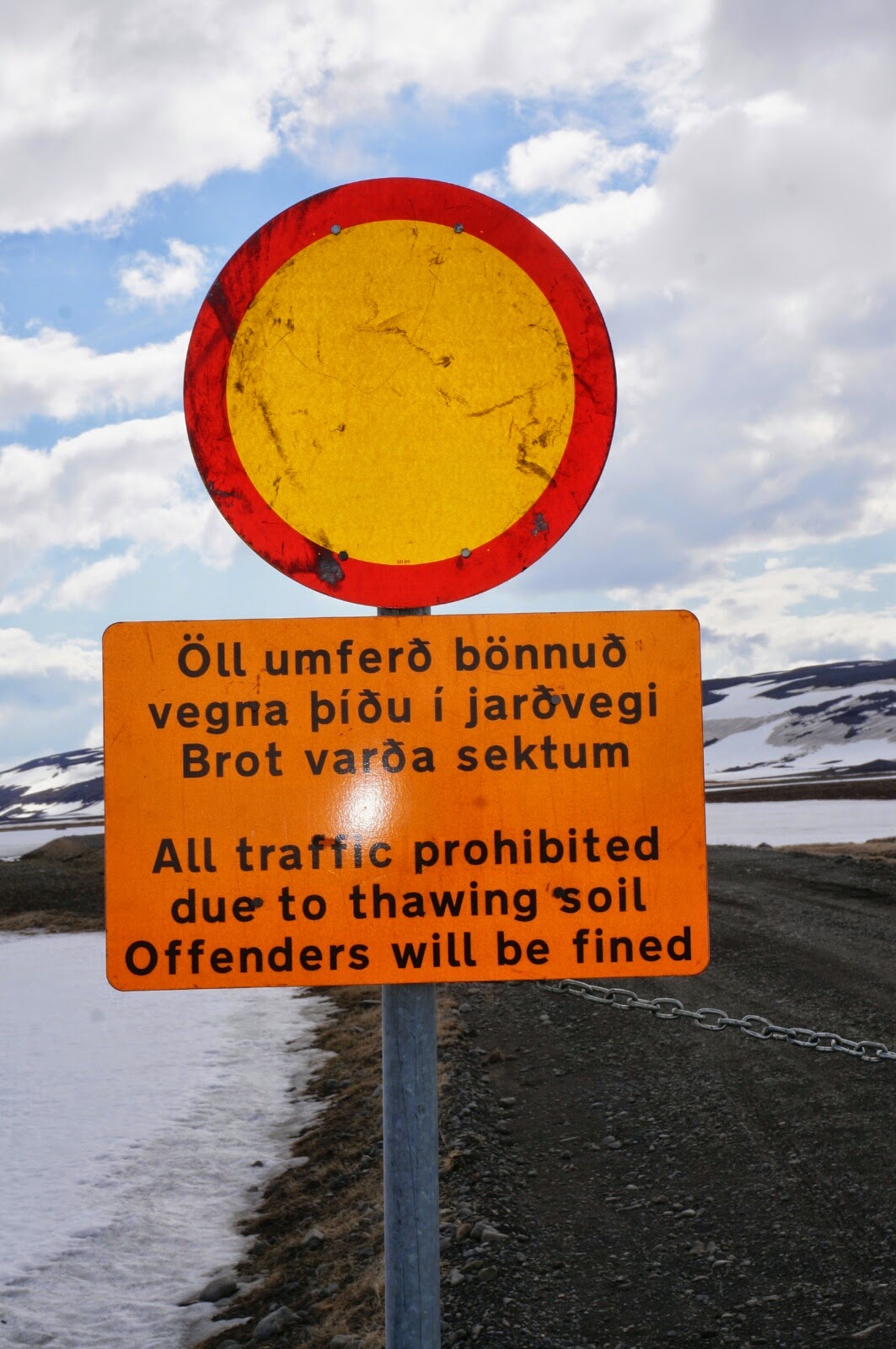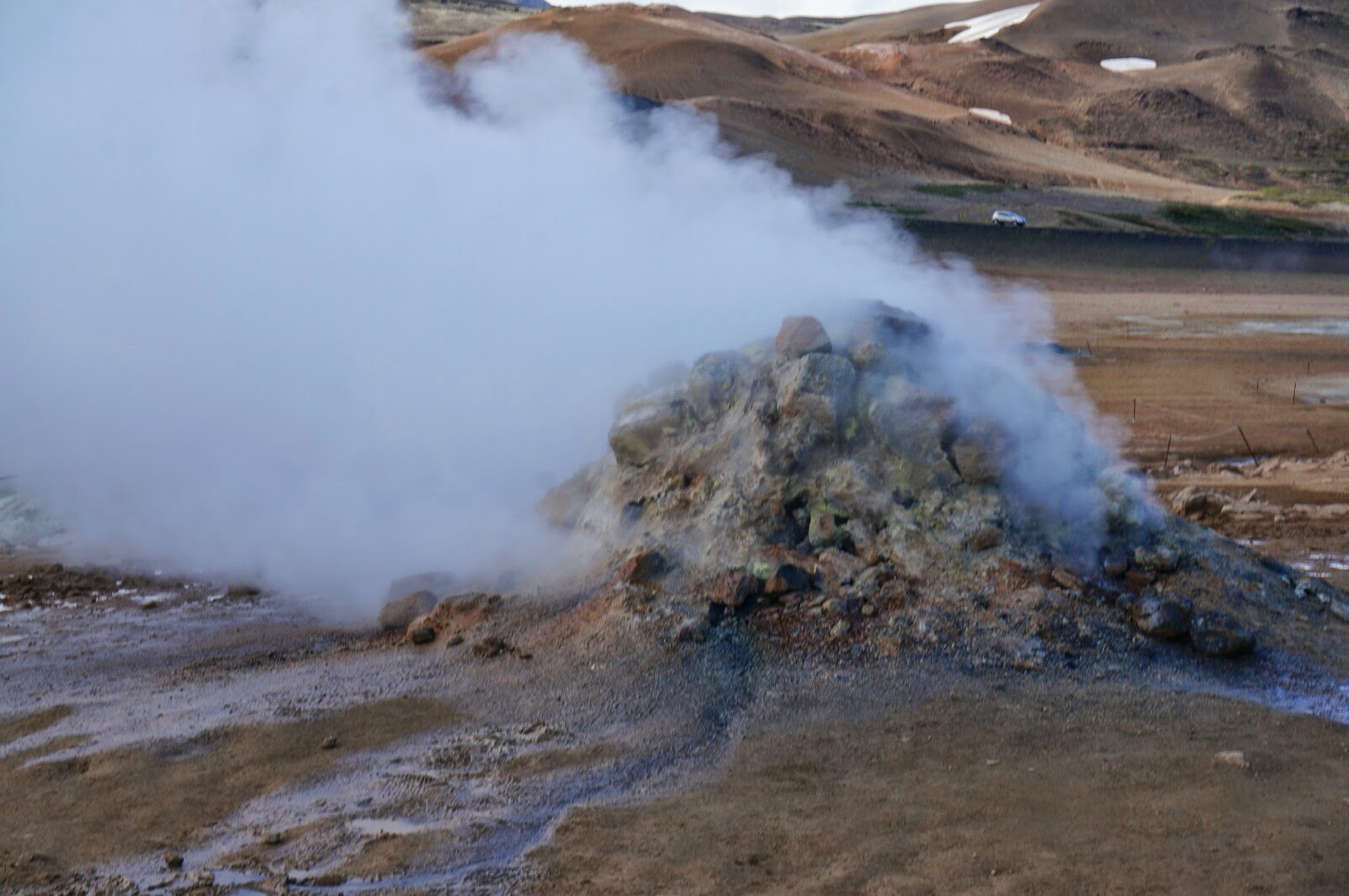Wednesday, June 4, 2014
Today was a LONG driving day, 9 hours. We went from fields of lupins to coastal villages to snow covered plains to lava terrain. At some points the road (which is narrow to begin with and has NO shoulder) was nothing but blind hills and sharp curves which would all of a sudden get you to an unexpected one lane bridge. We also went through a few tunnels, one 6 km long.
Today was a LONG driving day, 9 hours. We went from fields of lupins to coastal villages to snow covered plains to lava terrain. At some points the road (which is narrow to begin with and has NO shoulder) was nothing but blind hills and sharp curves which would all of a sudden get you to an unexpected one lane bridge. We also went through a few tunnels, one 6 km long.
We drove through the towns of:
Djúpivogur (Deep Bay) - originally established as a Danish trading post in the 1500s.
Djúpivogur (Deep Bay) - originally established as a Danish trading post in the 1500s.
Stöðvarfjörður - is a small village with 200 people. It is where Petra's Stone
Collection is located. Local resident Petra Sveinsdottir began
collecting rocks as a child 80 years ago. It is now one of the
largest of its kind in the world. She began by collecting stones
that she could use for drawing, and then collected stones for
decorations in little huts (called gullabú by the locals) that she
and her friends erected all over the village. The gardens were nice too. This attraction is one of the most popular in the area. Probably because there is NOTHING else in this area! And at this point, we would have paid the $10 just to use the facilities!
Fáskrúðsfjörður - a small village (population 662) nestled on a long fjord. It was
originally the base for French fishermen who would arrive each year
to fish in the Icelandic waters. All the street names are still
marked in Icelandic and French.
Reyðarfjörður - a trading port as well as a fishing port. Because of its
strategic location and good harbour conditions, it was used in World
War II as an Allied base. There is a World War II museum located at
the old camp above the town. We hemmed and hawed about going to this museum, but when we arrived it was not opening for another 15 minutes. Question answered.
We found the local grocery store to stock up on fresh nectarines but couldn't find any, but we did find chocolate. We stopped at one of the pullover picnic table sites and ate overlooking a beautiful mountain.
We found the local grocery store to stock up on fresh nectarines but couldn't find any, but we did find chocolate. We stopped at one of the pullover picnic table sites and ate overlooking a beautiful mountain.
Egilsstaðir - a town in east Iceland on the banks of the Lagarfljót river. In
its early days, it was a place of execution for criminals. Now
it is a supply depot for eastern Iceland.
Lagarfljót - a lake. We drove down about 10 km of one side of it and felt like the only 2 people in the world. The glacial-fed lake has very poor
visibility as a result of silt. It is famous because it is home to
the Lagarfljotsormurinn (Lagarfljót Worm or Serpent). Sightings go
back to 1345, and the serpent is said to be up to 300 feet long.
Legend has it that the great serpent in Lagarfljót grew out of a
small worm. The story goes that a girl was given a gold ring by her mother. She
put the ring under a worm in her linen
chest to gain profit from it. After a few days it grew so large that
it broke her chest. She was frightened and threw both the worm
and the gold ring into the lake, where the serpent continued to grow.
Early settlers of Iceland believed that a sighting was a bad omen of
a natural disaster or a sickness.
Now the Lagarfljotsormurinn is more of a mascot, and there is a
reward if anyone can photograph the elusive monster. The head of the
Icelandic National Forest Service claimed to have seen it in 1963.
Every country has to have its own Loch Ness Monster, apparently. The
sightings are likely the result of gas bubbles rising from the
lakebed and blowing debris from the lake bottom to the surface.
On the way back along the lake, our Icelandic map pointed out a spot called Hreidersstadir. We thought it might be interesting to check out, so we turned down that road only to find that it led to someone's farm. Very odd that a private farm would be listed on the official Icelandic map! Maybe the mailbox at the end of the road should have been our clue? In fact, we have noticed that all farms have names, and signs for them from the road.
On the way back along the lake, our Icelandic map pointed out a spot called Hreidersstadir. We thought it might be interesting to check out, so we turned down that road only to find that it led to someone's farm. Very odd that a private farm would be listed on the official Icelandic map! Maybe the mailbox at the end of the road should have been our clue? In fact, we have noticed that all farms have names, and signs for them from the road.
We also had no luck visiting Sænautasel, a turf farm that was built on the moorland in
1843. When we got there, the road was closed.
When we had almost reached Mývatn, we noticed steam coming from some fields. We stopped and discovered Hverir, a place of fumeroles and mud pots. A fumerole (Latin fumus, smoke) is an opening in a planet's crust, and these were billowing out hot steam so stupid tourists could put their hands in it.
The mud pots looked fun if they weren't 200 degrees.
We found our hotel, yeah we get to stay here for 2 nights! It's called Vogar Farm, and it REALLY is a farm! We arrived just in time to go in and visit with the cows (Anton got up and personal with a few) and watch them being milked. They let us try milk straight from the cow. We went in to the restaurant and sat at a table overlooking the area where they were milking the cows, so you could watch as you ate. And we had very yummy beef burgers for supper. Poor Betsy.
Our room is the cutest little cabin, a 3 minute drive ACROSS the road. Usually our accommodations have been in a separate building from the reception and dining, this time we have to drive there ha ha.
For the evening, we went to Mývatn Nature Baths. It has a bathing lagoon and several steam baths (saunas) which are small brown buildings that hold 50 bathers at a time. You can rent towels for only $6 (we brought ours from the hotel). The water comes straight from the power company's geothermic bore hole in Bjarnarflag, and has a temperature of 130C when it arrives. The water is cooled to 38-40C. There are 3.5 million litres of water in the lagoon and basin. The lagoon is man-made, but needs no chlorine or other chemicals because the water is so high in minerals. It is like the famous Blue Lagoon without the crowds of tourists, with little commercialization, and less than half the cost. At $70 for the two of us tonight, that's no joke! In the changeroom, we were very disappointed that the change police was not there tonight making sure we showered bare before entering. They actually do have change police. We left after 9 pm but the sun was still high in the sky. In the changeroom there was a bin that power-spun your bathing suit to help it dry afterwards. We felt SOOO relaxed when we came out!
When we had almost reached Mývatn, we noticed steam coming from some fields. We stopped and discovered Hverir, a place of fumeroles and mud pots. A fumerole (Latin fumus, smoke) is an opening in a planet's crust, and these were billowing out hot steam so stupid tourists could put their hands in it.
The mud pots looked fun if they weren't 200 degrees.
We found our hotel, yeah we get to stay here for 2 nights! It's called Vogar Farm, and it REALLY is a farm! We arrived just in time to go in and visit with the cows (Anton got up and personal with a few) and watch them being milked. They let us try milk straight from the cow. We went in to the restaurant and sat at a table overlooking the area where they were milking the cows, so you could watch as you ate. And we had very yummy beef burgers for supper. Poor Betsy.
Our room is the cutest little cabin, a 3 minute drive ACROSS the road. Usually our accommodations have been in a separate building from the reception and dining, this time we have to drive there ha ha.
For the evening, we went to Mývatn Nature Baths. It has a bathing lagoon and several steam baths (saunas) which are small brown buildings that hold 50 bathers at a time. You can rent towels for only $6 (we brought ours from the hotel). The water comes straight from the power company's geothermic bore hole in Bjarnarflag, and has a temperature of 130C when it arrives. The water is cooled to 38-40C. There are 3.5 million litres of water in the lagoon and basin. The lagoon is man-made, but needs no chlorine or other chemicals because the water is so high in minerals. It is like the famous Blue Lagoon without the crowds of tourists, with little commercialization, and less than half the cost. At $70 for the two of us tonight, that's no joke! In the changeroom, we were very disappointed that the change police was not there tonight making sure we showered bare before entering. They actually do have change police. We left after 9 pm but the sun was still high in the sky. In the changeroom there was a bin that power-spun your bathing suit to help it dry afterwards. We felt SOOO relaxed when we came out!












No comments:
Post a Comment